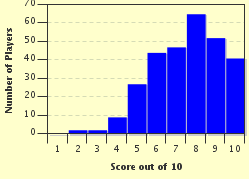Quiz Answer Key and Fun Facts
1. What part of a chicory can be roasted and used as a coffee substitute?
2. The spiralling curve of some species of forget-me-nots is the reason they have what vicious, alternate name?
3. If you know the full name of the poppy Meconopsis betonicifolia, you could probably guess that it is the national flower of what country?
4. Which of the following is a common alternate name for the lesser periwinkle?
5. Linseed, or common flax, is essentially a purely domesticated plant.
6. Hydrangeas are famous for their flowers changing colors, but what metal actually causes the change? (You likely have some in your kitchen right now.)
7. Because it grew in farmers' fields, this flower ended up with what common name?
8. The tall stalks and pea-shaped flowers of the Texas bluebonnet should suggest it is a type of what flower?
9. The morning glory is related to and bears flowers very similar to what edible tuber?
10. The Asiatic dayflower is so-called because its flower only lasts for a day.
Source: Author
nautilator
This quiz was reviewed by FunTrivia editor
Bruyere before going online.
Any errors found in FunTrivia content are routinely corrected through our feedback system.


